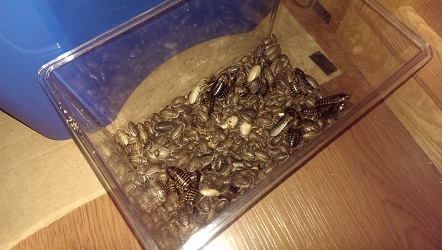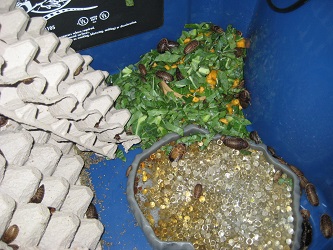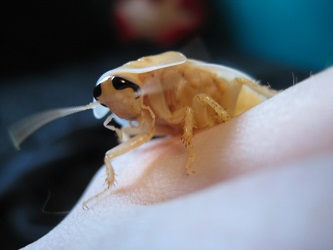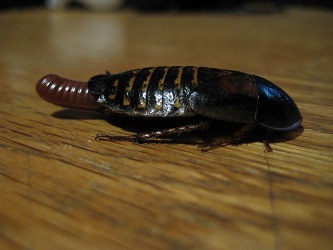Dubia Roaches
 Sometime around March of 2014 I started keeping a breeding colony of orange spotted cockroaches (Blaptica dubia) as feeders for my lizard, Errol. These particular insects have been amazing to keep and use as feeders. There is plenty of information out there about how to keep and breed these insects, but on this page I will go over my methods and observations I have compiled so far. First though, here's a brief overview of the basic information you need to know about these roaches.
Sometime around March of 2014 I started keeping a breeding colony of orange spotted cockroaches (Blaptica dubia) as feeders for my lizard, Errol. These particular insects have been amazing to keep and use as feeders. There is plenty of information out there about how to keep and breed these insects, but on this page I will go over my methods and observations I have compiled so far. First though, here's a brief overview of the basic information you need to know about these roaches.
Dubia roaches are native to Central and South America, so they need high temperatures and plenty of water to thrive. As adults, they can reach nearly 2 inches in length and are sexually dimorphic with males having fully developed wings covering their backs. However they are unable to sustain flight. These roaches are ovoviviparous and give birth to live young incubated internally in an egg sack called an ootheca. In the wild, the diet of a dubia roach mainly consists of decomposing fruits and vegetables.
My Roach Colony
Enclosure
 I keep my roaches in an opaque Rubbermaid container. To give the roaches air, and to regulate heat, I cut a hole in the lid and taped screen to it. This is not strictly necessary as long as your container is not airtight, but I find that allowing airflow into the container keeps humidity levels down so the frass stays dry and doesn't rot. I also prefer to use scraps of egg carton as it allows the container to be filled more completely and seems to prevent any roaches from being crushed under the weight of full sized egg flats. The only other items needed are food, water, and heating.
I keep my roaches in an opaque Rubbermaid container. To give the roaches air, and to regulate heat, I cut a hole in the lid and taped screen to it. This is not strictly necessary as long as your container is not airtight, but I find that allowing airflow into the container keeps humidity levels down so the frass stays dry and doesn't rot. I also prefer to use scraps of egg carton as it allows the container to be filled more completely and seems to prevent any roaches from being crushed under the weight of full sized egg flats. The only other items needed are food, water, and heating.
Heating
Many people like to use a heating blanket under the container they keep their roaches in. I personally am wary of this method due to seeing wood floors blackened and carpet and linoleum melted under roach habitats that use this. If you choose to use an electric blanket, It should be raised off the floor and have some airflow underneath as they are not designed to be used in such an enclosed space with no airflow.
My personal preference for heating is to use a stick-on undertank heater on one side of the inside of the container. Tape some aluminum foil or use aluminum tape on the outside of the tank opposite the heater to reflect escaping heat back inside. Using an undertank heater as big as you can fit on the long side of the container seems to keep everything exactly at the correct temperatures for the roaches and doesn't overheat even on direct contact. This does mean you will be running cords into the container that roaches could climb on, but I have yet to have any issues with escapes using this method.
Water
 Water is the easiest thing about keeping roaches. The only thing to keep in mind is that roaches will drown in open water, so you will need to use water crystals or water beads to give them hydration. You can buy water beads at most craft stores. These are often used in flower vases as a decorative way of keeping flowers watered. Water crystals are found in the gardening section of many hardware stores. Just make sure there are no additives to the water crystals. They should be clear when hydrated.
Water is the easiest thing about keeping roaches. The only thing to keep in mind is that roaches will drown in open water, so you will need to use water crystals or water beads to give them hydration. You can buy water beads at most craft stores. These are often used in flower vases as a decorative way of keeping flowers watered. Water crystals are found in the gardening section of many hardware stores. Just make sure there are no additives to the water crystals. They should be clear when hydrated.
As far as water dishes, many people use tupperware containers that have been roughed up with sandpaper. This is a great method, but I prefer using sloped plastic dog bowls roughed with sandpaper. Roaches seem to find their food and water more easily with the sloped sides and there's less touching the bottom to squish the roaches.
Food
 Roaches will eat just about anything you give them. However, you should remember that anything the roaches eat will be passed onto your pet, so choose your food with that in mind. As I have a bearded dragon, I feed my roaches a combination of dry cat food and cooking scraps. Dry cat food is a great staple for roaches, but there are a few things to keep in mind. an ideal protein source should come from vegetable protein, and you should look for the lowest protein content you can find. This would stick you with generally the cheapest cat food in the store. Cooking scraps should only be foods that won't make your pet sick. Whenever I make my lizard's salad for the week, the extra will be put in with the roaches.
Roaches will eat just about anything you give them. However, you should remember that anything the roaches eat will be passed onto your pet, so choose your food with that in mind. As I have a bearded dragon, I feed my roaches a combination of dry cat food and cooking scraps. Dry cat food is a great staple for roaches, but there are a few things to keep in mind. an ideal protein source should come from vegetable protein, and you should look for the lowest protein content you can find. This would stick you with generally the cheapest cat food in the store. Cooking scraps should only be foods that won't make your pet sick. Whenever I make my lizard's salad for the week, the extra will be put in with the roaches.
Cleaning
Cleaning up after roaches is easy. The hardest part is making sure you don't throw out too many nymphs. I generally clean my roach habitat once every month or two when the frass builds up to about an inch deep. When deciding whether or not to clean out the habitat, just use some common sense. If you see mold, you will need to clean and replace just about everything as mold will kill off your colony. If there's a smell, it may be time to clean, but it is more likely an indication that the diet needs to change. I've found that roaches fed on cat food give off a faint smell, but it shouldn't be strong. When cleaning out the frass, make sure to leave some and don't worry about getting it all. Roach nymphs feed on the frass until they grow older so if you clean all of it out, you will be stunting your colony's growth for a couple weeks.
Raising Roaches - What To Expect

When it comes to raising dubia roaches, care and maintenance are fairly hands off. Provided with heat, food, and water you will have no problems getting your roaches to breed. However, as these roaches have a long life cycle, your colony will not be ready to feed off for around 6 months - the amount of time it takes for nymphs to mature into adults.
Unlike many feeder insects, there is no need to have a special substrate for eggs or newly hatched insects. Dubia roaches incubated internally and hatched ready to survive on their own. There is little worry of roaches engaging in cannibalism, though I have observed a few dead roaches being eaten out of opportunity.

When finding a suitable place to keep the roach enclosure, I've found that a closet or other confined area works very well as it helps with keeping heat and humidity at the correct levels. Keeping the area dark will also help the roaches stay in an ideal environment for breeding and growth. Check on them every few days and replenish food and water as necessary. Also remove any food that is starting to rot. Mold will wipe out your colony!
These roaches do not bite, so don't worry about handling them when picking out feeders. You may feel a few sharp pokes - nothing painful, but if caught off guard they can be surprising. These are simply sensory hairs on their legs and pose no threat. They also are unable to climb up smooth surfaces, so make sure the inside of your enclosure is smooth and as vertical as possible. Dubia roaches seem to have little motivation to escape and I have never found a roach wandering around outside the enclosure, but given an easy opportunity they will certainly leave the enclosure.
I keep a small critter keeper with some food and water as well as a scrap of egg carton inside of it for about a week's worth of feeders. Doing this allows me to keep the main breeding enclosure as undisturbed as possible.
Obtaining Dubia Roaches
Dubia roaches can be ordered easily online. A breeding colony will generally cost somewhere between $50 and $100 after shipping. However, most states will have local sources of dubia roaches sold by people who breed their own. Check Craigslist to see if anybody local to you is selling off breeding colonies of their roaches. These local sellers seem to be around $30 for a starter colony of around 150 mixed roaches.
Keep in mind that - in the US - roaches are unable to be purchased in Florida and most online retailers will not ship to Alaska or Hawaii. Roaches are also illegal in Canada.
Convincing Housemates
Unfortunately, the word "roach" turns a lot of people off from these insects. I'm assuming since you found this page that you don't need any convincing. However, anyone you live with may need to be convinced that these feeders are safe to bring into the home. Below is a bulleted list of benefits that can help convince anyone you live with that these insects won't be a bother.
- Dubia roaches do not smell. Even in their thousands the smell of any food you use will overwhelm any natural scent of the roaches. "Fresh earth" is the best way to describe it.
- Dubia roaches do not fly, climb, or jump. This makes containing them very easy. If any happen to get out during a cleaning, they are very easy to catch.
- Dubia roaches cannot breed in normal household conditions. They need high heat and humidity to be able to breed. Nymphs can't molt without this and will die off. Even if any escape, they will not become a pest.
- Dubia roaches do not make any sound. Aside from a quiet rustling when the enclosure is disturbed, you will not hear any sound from the roaches. Ever had a cricket loose in your house. No more of that annoying chirping you can't locate!
All content and code, unless otherwise specified, is copyright 2004 - 2018 Callen Magnuson.
mmmh... spam...